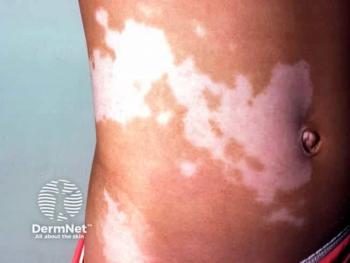
Study: Correlation of VASI with PaGIC-V, PhGVA
A recent JAAD study evaluated the correlation between F-VASI and T-VASI using patient- and physician-reported measures of clinical improvement, PaGIC-V and PhGVA.
A recent randomized, double-blind phase 2 study of 157 patients with vitiligo in the Journal of the American Academy of Dermatology examined the correlation between facial and total Vitiligo Area Scoring Index (F-VASI and T-VASI, respectively).1 This was evaluated through patient- and physician-reported measures of clinical improvement, including Patient Global Impression of Change-Vitiligo (PaGIC-V) which uses a 7-point scale, and Physician’s Global Vitiligo Assessment (PhGVA).
Stable study patients—having no change from baseline in PaGIC-V, a score of 4—showed VASI scores with “excellent test-retest reliability (≥ .95) at weeks 12 and 24,” investigators wrote.
Additionally, significant differences in VASI were seen among PhGVA categories (mild, moderate, severe) at baseline and change in disease status was detected by the VASI during the treatment period. These differences were detected between patients showing improvement (PaGIC-V, 1-3) or those who had worsening (PaGIC-V, 5-6) vitiligo (Pearson’s r ~.45, P < .0001).
Interpretability was assessed using an anchor-based PaGIC-V (score of 1 or 2) approach to define clinically meaningful change (CMC) on the VASI at 24 weeks, according to the study.
The mean CMC shown was 57% for F-VASI and 42% for T-VASI, indicating that a higher percentage of patients treated with 1.5% ruxolitinib cream (Opzelura; Incyte Dermatology) “met or exceeded CMC thresholds vs vehicle on F-VASI (39.4% vs 3.1%; P = .0005) and T-VASI (27.3% vs 0%; P = .002),” investigators wrote.
The study concluded that the efficacy analysis using F-VASI and T-VASI showed meaningfully relevant changes in patients with vitiligo.
Reference:
1. Hamzavi I, Rosmarin D, Butler K, Kuo F, Zhu Z, Sun K. 25486 Correlation of the vitiligo area scoring index with patient- and physician-reported measures of clinical improvement in a randomized, double-blind phase 2 study. Journal of the American Academy of Dermatology. 2021;85(3):AB60.
Newsletter
Like what you’re reading? Subscribe to Dermatology Times for weekly updates on therapies, innovations, and real-world practice tips.


















